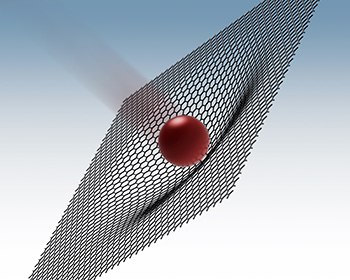
Artist's rendering shows 3.7 micron microbullet, fired at supersonic speeds, penetrating a graphene layer. [Image: Jae-Hwang Lee/Rice University]
Graphene has become almost proverbial as a material of incredible strength, but its full robustness under extreme conditions has been obscure. Now, a team of scientists at Rice University, USA, has put the 2-D material to an unusual strength test, firing a fusillade of tiny “microbullets” impelled by a laser blast into graphene strips and measuring their impact (Science, doi: 10.1126/science.1258544). The upshot from this micro-firing range: Graphene is very strong stuff indeed—some ten times stronger than steel.
To perform this minuscule ballistic experiment, the team used sheets of multilayered graphene between 10 and 100 nm thick, drawn from bulk graphite, and tiny projectiles approximately 3.7 microns in diameter. To fire off the bullets, they relied on a previously developed technique that uses energy from a laser pulse to drive the microbullets away from an absorbing gold surface at high speeds—velocities approaching 3 km/s in the current experiments. A high-speed camera captured the before-and-after states of both the projectiles and the graphene sheets. A Rice University video describes the experiments:
The experiments confirmed the remarkable strength of graphene. Measurements of the deformation cone in the graphene as a result of the collision, and before-and-after measurements of the bullet velocity, revealed that graphene is ten times better than steel of similar thickness at absorbing the impact’s kinetic energy. The results, in the view of the researchers, underscore the potential effectiveness of graphene—which is, simultaneously, strong, lightweight, and elastic—in body armor, impact shielding for spacecraft and other energy-absorbing materials for which weight is a key factor. More generally, the team believes that its laser-driven microballistic method could prove useful in exploring the “high-strain-rate physics” of materials well beyond grapheme.
